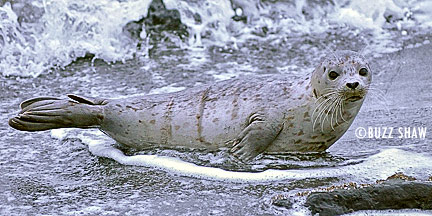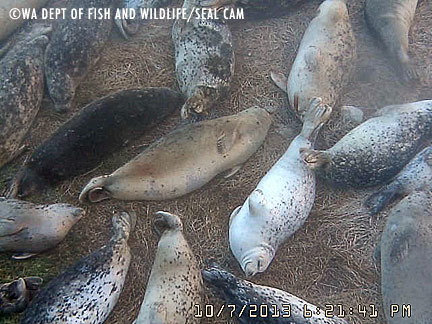Seal pups on shore briefly today and others hanging around
Oct/11/13 09:47 PM

Later in the afternoon, 4 pups were observed foraging along the shoreline, but none that we know of came ashore. A pup was also sighted briefly on the protected beach at Jack Block Park. Perhaps the pups are resting at night or in locations that are less visible. The good news is, however, that we have pups still hanging around West Seattle and that they seem to be actively feeding. In the photo you can see Tiger’s long whiskers which detect vibrations from prey in the water. A recent study showed that the highly sensitive vibrissae contain thousands of nerves which enable a seal not only to locate prey, but determine size and species. This is why harbor seals are very effective hunters even at night or in deep, dark waters.
All of the harbor seal pups in South Puget Sound are now fully weaned. Almost all of the youngsters have left the relative safety of the rookeries to venture off on their own - and area haul-outs are full of grumpy adult seals, molting their coats and spending extended time on shore and less time feeding. While the molting process of harbor seals is not as grueling as the “catastrophic molt” of elephant seals, it is still a very trying time, particularly as winter months approach. Females who expended all of their resources to nurse pups for 4-6 weeks now face the additional physical stress of the molt. Thanks to WDFW-MMI for providing this seal cam photo of a freshly molted seal with a smooth new coat along with others who are still molting. Don’t forget to check out the WDFW seal cam webpage for a real-time look at a harbor seal haul-out and lots of informative articles and videos.
Haul-outs this time of year are not a welcoming place for new “weaners” to linger. All the more reason we need to offer them sanctuary on our urban beaches.








